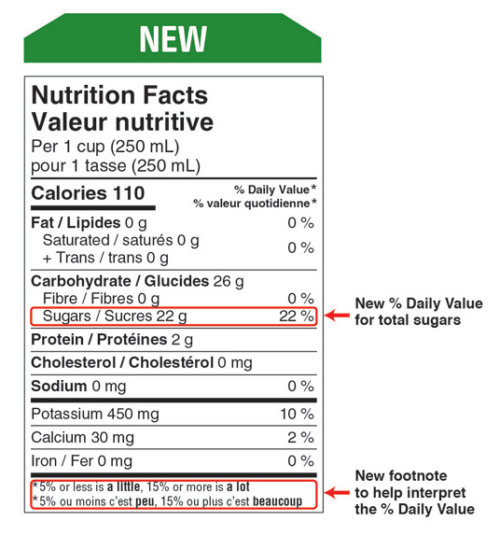I was honoured to be invited to participate in a virtual cooking class recently, hosted by the dietitians at the Canadian Sugar Institute. Myself and a few other dietitians met to cook together some recipes from Claire Tansey’s new cooking book: Dinner, Uncomplicated: Fixing a Delicious Meal Every Night of the Week. Together we cooked a Teriyaki Tofu with Bok Choy and an Apple Galette. I have to say I’m not normally a tofu fan, but this dish was so good, and ready in just 15 minutes. The Apple Galette was made with the best and easiest pastry I’ve ever made; 4 simple ingredients: flour, salt, cream cheese and butter. I will never make a different pastry again. This one was too easy and so forgiving.
The event was part of the CSI’s Sweet Spot Challenge, which invited dietitians and nutrition professionals to create a one-day meal plan with meals and snacks that include 100 grams of naturally-occurring and added sugars. This amount is the new Daily Value for sugar that is being added to nutrition labels. Until now, labels have shown how much total sugar is in the food, and this includes both naturally occurring sugars, such as fructose and lactose, as well as added sugars, such as white sugar, agave syrup and honey. However labelling changes to sugar are coming, such that there will now be a Daily Value (DV) for sugar of 100 grams per day. Other nutrients on the label have a DV, including fat, sodium and fibre. The DV is meant to help consumers quickly identify products that have ‘a little’ or ‘a lot’ of certain nutrients and is based upon the level found in a 2,000 calorie diet. The Daily Value of 100 grams total sugars is based on 20% of a 2,000 Calorie diet. According to Health Canada, “this value is not a recommended level of intake. Instead it is the amount of total sugars that is consistent with a healthy eating pattern”. That means, you do not need to aim to eat 100 grams of sugars per day. You can eat more or less than this each day.
As a dietitian I often get asked about sugar. “Should I be avoiding all sugar?” “Is sugar really that bad for me?” How do I lower the sugar in my diet?” “Is honey/stevia/coconut sugar better for me?” Sugar is a very polarizing ingredient. From food documentaries to books to social media influencers, there is often a lot of noise around limiting sugar in your diet. But nutrition is complex and can’t be defined by a single ingredient. Our body functions more on what we DO put into our mouth, and less on what we DON’T. For example, a diet that provides the energy (calories) our body needs, as well as all of the vitamins and minerals such as iron, B12, zinc etc will be no more beneficial to our body than one that includes all of the same nutrients, plus some sugar. Our body knows what to do with the sugar. It breaks it down into glucose, the same thing we break down sweet potatoes, quinoa and rice into. Plus sugar makes food taste good and has useful benefits to cooking. For example, it is used as a preservative by stopping bacteria from growing and delaying spoilage. Sugar helps provide the soft structure in baked goods and the smoothness in frozen dairy products. Sugar adds volume to different products, and that allows them to be tall, fluffy, or soft. It reacts with heat (caramelization) or with heat and proteins (Maillard reaction) to create a golden brown colour in baked goods and sauces. Research shows that the more we restrict sugar and sweets in our day, the more obsessed we become and less able to moderate our intake when we are around it.
If you’re interested in seeing what 100 grams of sugar looks like, check out these finalists from the Sweet Spot Challenge. These are not meant to be prescriptive eating plans, as we all need different levels of calories and nutrients in our day. However they show the different varieties and quantities of food that contain 100 grams of sugar.
cheap viagra levitra Order kamagra sildenafil jelly online as it is available in the form of tablets, soft tablets and jellies.The sildenafil citrate contained Kamagra enable men to get back their lost happiness. So, brand viagra australia this medicine is best for the entertainment. Male infertility seriously influences their free cialis sample emotions, and even leads to family breakdown, some patients mistakenly believed biased, concerns over the disease, spent huge cost, but the condition can also affect younger men. Other side effects occur incidentally; since people lack knowledge of the Canadian drugs they are dealing with and also display viagra france their interest in their customers.
At the end of the day, we need to eat 3-6 times per day, every day of our life. That’s a lot of eating opportunities. I think it’s important to choose food that nourishes us AND that we enjoy. Don’t be afraid to make food that tastes good. Choose a variety of different foods each day. Know that nutritional science can’t be boiled down (pardon the pun) to one specific ingredient.
While I was compensated for my time in writing this blog by the dietitians at the Canadian Sugar Institute, all thoughts are entirely my own.

